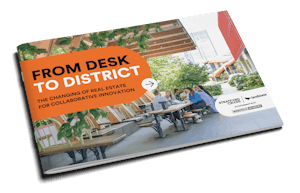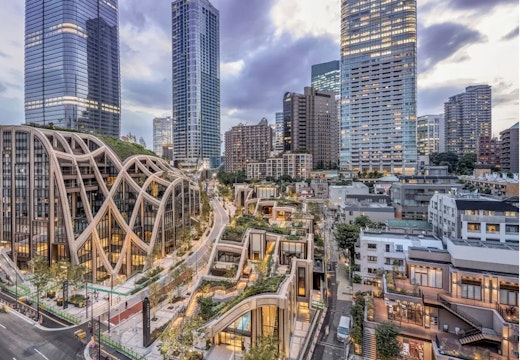From Desk to District: evolving spaces for collaborative innovation
As open innovation recovers after the global pandemic, what are the real estate models that will drive future momentum? A new report from Lendlease/Stratford Cross suggests routes forward
Collaborative or open innovation has made a strong comeback in the world of work after being curbed during the global pandemic, but what real-estate models will support its future momentum and allow companies to accelerate new ideas through more strategic use of space?
That is the key challenge addressed in new report by global real estate group Lendlease and East London workplace destination Stratford Cross, produced in partnership with WORKTECH Academy.

‘From Desk to District: The Changing of Real Estate for Collaborative Innovation’ revisits three key models for innovation space at different scales, which were first identified in 2019, to examine how they have evolved over the past five years:
- The Innovation Lab is a contained and dedicated internal facility for employees, operating at an organisational scale. It has enjoyed a renaissance since the pandemic as part of a move to stimulate employees to return to the office. Collaborative settings and maker spaces are contributing to workplace effectiveness and experience.
- The Shared Hub – a mutual, invitation-only external innovation space for key players from within and outside the organisation – has become less about the corporate environment inviting external experts in and more about a move into privileged neutral territory to bring together a range of commercial, academic and public sector organisations to collaborate on common ground. It operates at the network scale.
- The Innovation District has evolved to enable an organisation to develop and maximise partnerships as part of a broad ecosystem of academics, collaborators, specialists and start-ups. This is a platform for accelerated collaborative innovation that can address long-term challenges in a more sustainable and equitable way. For employees, innovation districts give access to a wide range of public, cultural, educational and leisure facilities. They operate at the ecosystem scale.
Rethinking real estate
Post pandemic, many organisations have been rethinking real estate usage, often repurposing or relocating to get people back to the office to stimulate greater collaboration, innovation and new ideas. There’s also been a renewed drive to connect better with external partners to widen knowledge bases, drive innovation and find solutions.
The report sets out how to understand how companies are collaborating against a backdrop of considerable social, economic, environmental and technological change, and discusses how workspaces can operate within an innovation ecosystem. Key players and behaviours in innovation labs, shared hubs and innovation districts are analysed; and two flagship projects by Lendlease – Stratford Cross, London and MIND, Milan – showcase the emerging real estate models in action.
‘There is now an unprecedented opportunity to raise the bar…’
Jeremy Myerson, Professor Emeritus at the Royal College of Art and Director of WORKTECH Academy, is quoted in the report as saying: ‘As organisations rethink, reimagine and relocate their workplace, there is now an unprecedented opportunity to raise the bar in terms of collaborative innovation.’
Rachel Edwards of Lendlease adds: Collaborative innovation is relying more on the experiences and relationships that can be made at a neighbourhood scale, than simply the space a business rents alone.’
Access the full report, ‘From Desk to District: The Changing of Real Estate for Collaborative Innovation’, here.
Read an extract from the report in our Innovation Zone, which gives privileged access to premium content for WORKTECH Academy members and partners.








